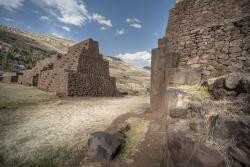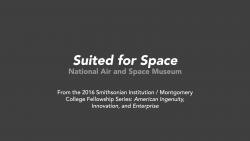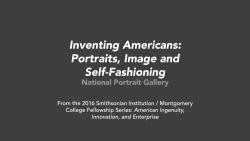Tess Porter
User Experience Strategist (she/her)
Smithsonian Office of Educational Technology
I'm the former User Experience Strategist at the Smithsonian Office of Educational Technology. Here, I focused on the use of digital museum resources to support teaching and learning. My work draws on my experience as a museum educator, digital analyst, usability researcher, and content designer. I hold a B.A. in Anthropology and a B.A. in Art History from University Colorado Boulder, and an M.S. in Museums and Digital Culture with an Advanced Certificate in User Experience from Pratt Institute.
Tess Porter's collections
Eudora Welty: Examining Portraiture
<p>This teacher's guide provides a portrait and analysis questions to enrich students' examination of Eudora Welty, a Pulitzer Prize-winning author known for her evocative novels and short stories set in the American South. Includes the video "Defining Portraiture: How are portraits both fact and fiction?" and the National Portrait Gallery's "<em>Reading" Portraiture Guide for Educators, </em>both of which provide suggestions and questions for analyzing portraiture. Also includes a video and blog post that look closely at this portrait, as well as a related article about Mississippi's new writers trail that may be used as a lesson extension.</p>
<p>Consider:</p>
<ul><li>How is this portrait both fact and fiction?</li><li>How does this portrait reflect how Eudora Welty wanted to be seen, or how others wanted her to be seen? Consider for what purpose this portrait was created.</li><li>Having read one of her stories, does the portrait capture your image of Eudora Welty? Why, or why not?</li><li>If you were creating your own portrait of Eudora Welty, what characteristics would you emphasize, and why?<em></em></li></ul><p>Keywords: mississippi, ms, story, optimist's daughter, writer, #BecauseOfHerStory</p>
 Tess Porter
Tess Porter
6
William Faulkner: Examining Portraiture
<p>This teacher's guide provides portraits and analysis questions to enrich students' examination of William Faulkner, an American author and Nobel Prize laureate. Includes the video "Defining Portraiture: How are portraits both fact and fiction?" and the National Portrait Gallery's "<em>Reading" Portraiture Guide for Educators, </em>both of which provide suggestions and questions for analyzing portraiture. </p>
<p>Consider:</p>
<ul><li>What do these portraits have in common? How are they different?</li><li>How are these portraits both fact and fiction?</li><li>How do these portraits reflect how they wanted to be seen, or how others wanted them to be seen? Consider for what purpose these portraits were created (such as the caricature, stamp, etc.).</li><li>Having read one of his stories, does the portrait capture your image of William Faulkner? Why, or why not?</li><li>If you were creating your own portrait of William Faulkner, what characteristics would you emphasize, and why?</li></ul><p>Keywords: mississippi, ms, the sound and the fury, writer</p>
 Tess Porter
Tess Porter
6
Richard Wright: Examining Portraiture
<p>This teacher's guide provides portraits and analysis questions to enrich students' examination of Richard Wright, an American author whose works investigate the toll that racial prejudice exerted on society. Includes the video "Defining Portraiture: How are portraits both fact and fiction?" and the National Portrait Gallery's "<em>Reading" Portraiture Guide for Educators, </em>both of which provide suggestions and questions for analyzing portraiture. </p>
<p>Consider:</p>
<ul><li>What do these portraits have in common? How are they different?</li><li>How are these portraits both fact and fiction?</li><li>How do these portraits reflect how they wanted to be seen, or how others wanted them to be seen? Consider for what purpose these portraits were created (such as the stamp, etc.).</li><li>Having read one of his stories, does the portrait capture your image of Richard Wright? Why, or why not?</li><li>If you were creating your own portrait of Richard Wright, what characteristics would you emphasize, and why?</li></ul><p>Keywords: mississippi, ms, writer, native son</p>
 Tess Porter
Tess Porter
6
Suffrage Pin: Object Analysis
<p>Using the Project Zero Visible Thinking routine "See Think Wonder," this activity explores the struggle of suffragists during the American suffrage movement through deep analysis of one object - a pin, worn by suffragist Alice Paul, in the shape of a jail door with a heart-shaped lock. Pins such as these were given in a ceremony to suffragists who were imprisoned as a result of the 1917 pickets. Includes the pin, an article discussing the history behind the pin, and multiple photographs suffragist picketers.</p>
<p>Keywords: women's rights, suffrage, suffragette, protest, reform, civil rights, equal rights, alice paul, jailed for freedom, pin, national women's party, nwp, voting, vote</p>
 Tess Porter
Tess Porter
6
Reading Companion: Robots
This collection is a reading companion to two articles - "Robot Zoo" [Ask; Nov 2011] and "Me, Myself, and My Android Twin" [Muse; Nov 2012]. Students are asked to investigate these articles, alongside other objects, videos, and articles, to examine what issues robot designers are attempting to address with their inventions, and how they are trying to address them. At the end of the activity, students will be asked to write a paragraph or more explaining which inventions they think are the most important and why, citing resources in this collection as evidence.
 Tess Porter
Tess Porter
21
Civil Rights Sculpture: Claim Support Question
<p>Using the Project Zero Visible Thinking routine "Claim Support Question," a routine for clarifying truth claims, students will examine a portrait of Rosa Parks, a prominent civil rights activist whose refusal to give up her bus seat to a white passenger prompted the 1955-56 Montgomery bus boycott. After discussing the portrait with their peers, students will learn more about the arrest this sculpture depicts by reading the original police report, with notes by a Smithsonian curator.</p>
<p>Created for the 2016 National Portrait Gallery Summer Teacher Institute.</p>
<p>Keywords: african-american, black, civil rights movement, female, woman, women, segregation, NAACP, justice, arrest, #BecauseOfHerStory</p>
 Tess Porter
Tess Porter
3
Key Moments in WWII: What makes you say that?
<p>Using the Project Zero Visible Thinking routine "What makes you say that?," students will investigate two photographs, taken from different angles, of Japanese Foreign Minister Mamoru Shigemitsu and General Yoshijiro Umezu aboard the USS Missouri as they signed the surrender that would officially end WWII.</p>
<p>Keywords: world war 2, world war ii, general macarthur, carl mydans, primary source, ww2, japanese instrument of surrender, potsdam declaration, inquiry strategy, japan</p>
<p><em>#visiblethinking</em><br></p>
 Tess Porter
Tess Porter
6
Bracero Program: Unveiling Stories
<p>In this activity, students will examine photographs documenting the Bracero Program, the largest guest-worker program in US history. Started in 1942 as a temporary war measure to address labor demands in agriculture and railroads, the program allowed Mexican nationals to take temporary agricultural work in Texas, New Mexico, Arizona, California, and 24 other states. By the time the program ended in 1964, over 4.6 million contracts were awarded. </p>
<p>Using two Project Zero Global Thinking Routines - "Unveiling Stories" and "The 3 Ys" - students will analyze the stories these photographs tell about the experiences of braceros in this program, and the impact of these stories in multiple contexts. Additional resources (primary sources, a digital exhibition, and an article) and information on how to use these routines in the classroom can by found by clicking <em>Read More »</em>.</p>
<p>Keywords: mexican, immigration, work, migration, migrant workers, agriculture, reform, politics, government, leonard nadel, photojournalism, activity, inquiry strategy, global competency, global competence, latino, chicano, California, Arizona, New Mexico, Texas, Arkansas, 1940s, 40s, 1950s, 50s, 1960s, 60s
</p>
<p>#LatinoHAC #EthnicStudies</p>
 Tess Porter
Tess Porter
37
The Bikini Atoll and Operation Crossroads: Unveiling Stories
<p>In this activity, students will analyze photographs documenting the exodus of Bikini islanders from Bikini Atoll prior to Operation Crossroads, a pair of nuclear weapons tests and the first detonations of nuclear devices since the bombing of Nagasaki. These photographs were taken by Carl Mydans and were published in the LIFE Magazine article, "Atomic Bomb Island," on March 25, 1946. </p>
<p>Using two Project Zero Global Thinking Routines - "Unveiling Stories" and "The 3 Ys" - students will analyze the stories these photographs communicate about the experiences of the Bikini islanders and America's perspective on military advancement after WWII. They will also consider the perspectives presented by these photographs, in multiple contexts from the personal to the global. Additional resources (primary sources and the original article) and information on using this collection in the classroom can by found by clicking <em>Read More ».</em></p>
<p>Keywords: atomic testing, atomic bomb, operation crossroads, bikini islands, bikini atoll, rongerik, able test, baker test, nuclear bomb, photojournalism, inquiry strategy, global competence, global competency, 1940s, 40s, 1950s, 50s, 1960s, 60s
</p>
<p><br /></p>
 Tess Porter
Tess Porter
17
Identity, Community, and Fire Hats
<p>What can objects reveal about the values and beliefs of the people who created them? Explore fire hats, worn by volunteer fire fighters on the East Coast during the 1800s. Created for use during both fires and parades, these ornate hats contain symbols – historical figures, allegorical images, patriotic scenes, and more – that proclaim the wearers' cultural and political identity, as well as their positions on religion and immigration. What symbols do you see?</p>
<p>This collection contains a small selection of fire hats from the Smithsonian. To continue exploring, <a href="https://learninglab.si.edu/search/?f%5B_types%5D%5B%5D=resource&st=fire%20hats&providers%5B%5D=National%20Museum%20of%20American%20History&s=&page=1">search for fire hats in the Smithsonian Learning Lab</a>. </p>
 Tess Porter
Tess Porter
12
Inka Architecture: Teaching Resources
<p>This topical collection gathers teaching resources on Inka architecture, focusing on building methods and architectural symbolism in Cusco, capital of the Inka Empire. These resources explore the symbolic layout of Cusco as well as the architecture of five specific structures: Saqsaywaman (upper temple of the sun), Hatunrumiyoc (a wall, once part of the palace of Inka Roca), the Qorichanka (lower temple of the sun), and the Double Jamb Doorway (a sacred entryway). Includes video interviews with archaeologists, interactive 3D models, and the exhibition website for "The Great Inka Road: Engineering an Empire." Resources also explore the continuing importance of these structures in Cusco today, both in terms of environmental stability and continuing cultures.</p>
<p>Keywords: inkan, inca, incan, archaeologist, stonework, continuing legacy, peru, symbol, religion, ancient civilization, world history, culture, cuzco, andes, saksaywaman, qurikancha, archaeology, pre-columbian, latin america, south america, ruins</p>
 Tess Porter
Tess Porter
23
Investigating: Civil War Portraits
<p>In this student activity, students will investigate nine portraits of people involved in the Civil War, both from the Union and the Confederacy. Through these portraits, students will gain an understanding of: experiences of people on both sides of the war; why these people are seen as historically significant; and how portraiture can communicate how a person wanted to be seen, or how others wanted them to be seen. Included with each portrait is a video that explains the historical significance of the person depicted. Activity extension ideas can be found by clicking "Read More."</p>
<p>Big Ideas: </p>
<ul><li>Why are these people, and the developments they shaped, seen as historically significant? </li><li>How does portraiture communicate how a person wanted to be seen, or how others wanted them to be seen?</li></ul><p>Keywords: thomas stonewall jackson, william tecumseh sherman, john pelham, elmer e ellsworth, george armstrong custer, jefferson davis, abraham lincoln, clara barton</p>
 Tess Porter
Tess Porter
10





